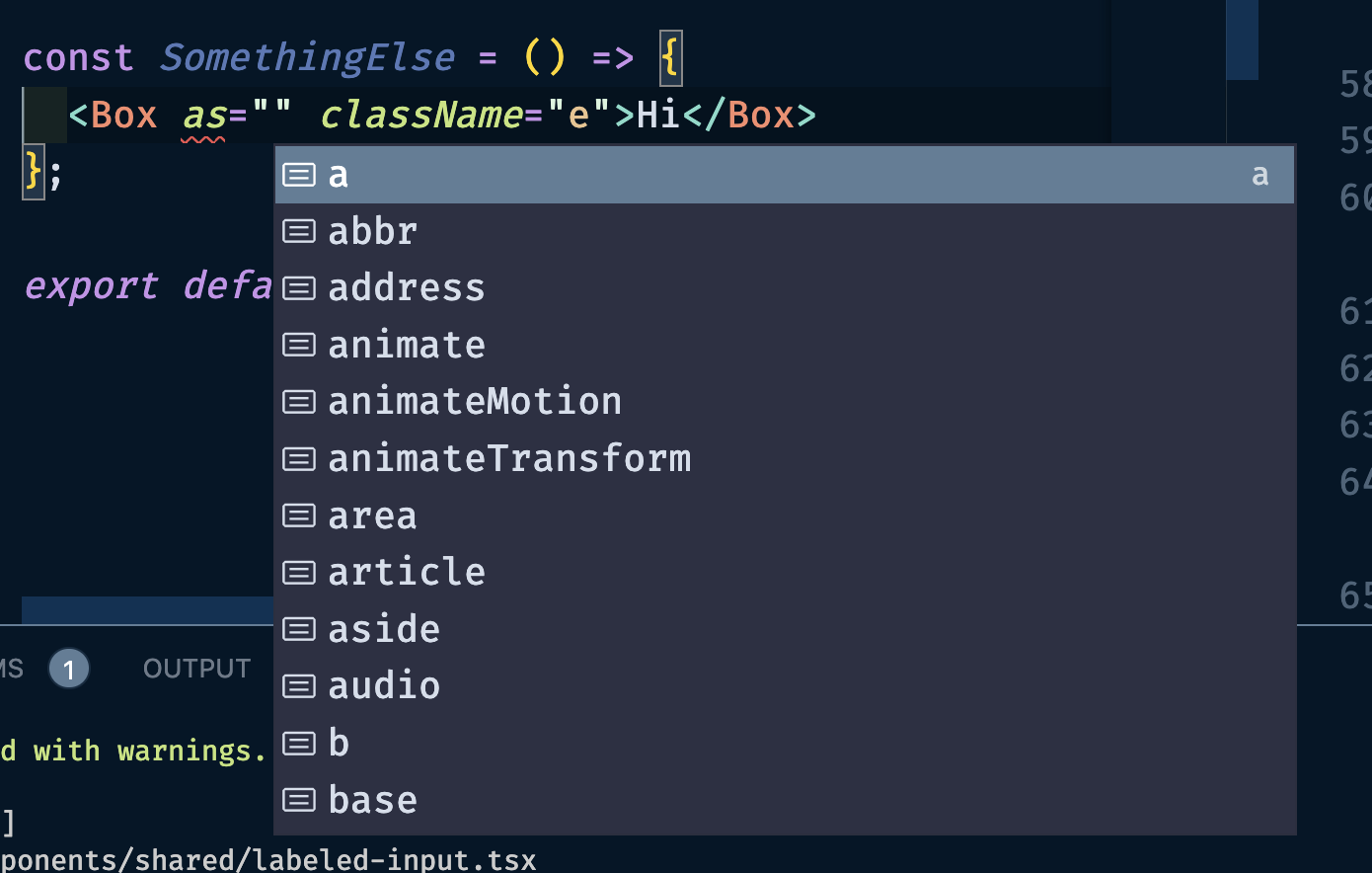Polymorphic components
Let's walk along the razors edge between practical and academic. I'm including this section because once or twice, I've needed to use the techniques we're about to cover, but those occasions were few and far between.
When I worked at Twilio, they had a team dedicated to building out their design system, Paste. The foundational component was Box. Everything was build on top of Box.
Did you need to build something custom that wasn't in Paste? Fine, but start with Box.
Here is an example from their documentation on Box.
<Box as="article" backgroundColor="colorBackgroundBody" padding="space60">
Parent box on the hill side
<Box
backgroundColor="colorBackgroundSuccessWeakest"
display="inline-block"
padding="space40"
>
nested box 1 made out of ticky tacky
</Box>
</Box>
Earlier, I told you that over the course of building out a large application, I tend to end up making a few wrappers around components. Box is a primitive wrapper around the basic block elements in HTML (e.g. div, aside, section, article, main, head, etc.). But, like we don't want to lose all of our semantic meaning that we get from all of these tags, but we also don't need like 20 variation on Box that are all basically the same. What we'd like to is use Box but also be able to specify what it ought to be under the hood.
Here is an overly-simplified take on a Box element inspired by Styled Components.
import { PropsWithChildren } from 'react';
type BoxProps = PropsWithChildren<{
as: 'div' | 'section' | 'article' | 'p';
}>;
const Box = ({ as, children }: BoxProps) => {
const TagName = as || 'div';
return <TagName>{children}</TagName>;
};
export default Box;
We refine as to something JSX will respect as a component type and it all works out.
Well, not really. I can't exactly pass any props to it. I could get away with something like this:
type BoxProps = ComponentPropsWithRef<'div'> & {
as: 'div' | 'section' | 'article' | 'p';
};
const Box = ({ as, children }: BoxProps) => {
const TagName = as || 'div';
return <TagName>{children}</TagName>;
};
I honestly don't even know if like sections have any properties that div doesn't and while I am sure I could look it up, none of us feel good about this implementation.
But, like what's that 'div' being passed in there and how does it work? If we look at the type definition for ComponentPropsWithRef, we see the following:
type ComponentPropsWithRef<T extends ElementType> = T extends new (
props: infer P,
) => Component<any, any>
? PropsWithoutRef<P> & RefAttributes<InstanceType<T>>
: PropsWithRef<ComponentProps<T>>;
Nevermind all of those ternaries. I am interested in ElementType right now.
type BoxProps = ComponentPropsWithRef<'div'> & {
as: ElementType;
};

Okay, that's interesting, but what if I wanted the type argument I give to ComponentPropsWithRef to be the same as… as?
We could try something like this…
type BoxProps<E extends ElementType> = Omit<
ComponentPropsWithoutRef<E>,
'as'
> & { as?: E };
And we should now see that we have type that adapts to whatever it is set to.
Extension
We can expand on this to do something like this:
import { ComponentPropsWithoutRef, PropsWithChildren } from 'react';
type ButtonType = 'a' | 'button';
type ButtonProps<T extends ButtonType, E = ComponentPropsWithoutRef<T>> = {
as?: T;
} & PropsWithChildren<E>;
const Button = <T extends ButtonType = 'button'>({
as,
...props
}: ButtonProps<T>): JSX.Element => {
if (as === 'a') {
return <a {...props}>{props.children}</a>;
}
return <button {...props}>{props.children}</button>;
};
const Example = () => {
return (
<div>
<Button type="submit">Hello</Button>
<Button href="http://wow.com">Link</Button>
</div>
);
};
export default Example;
Further Reading
There is a lot more that we could discuss on this topic, but that's probably not only a workshop in and of itself but one that is more of academic exercise than something you're going to practically need to use in your day-to-day endeavors—unless you're building a highly generalized library or working something like React's types directly. Out of curiosity, I took a look at Paste's Box implementation and they just did the work of listing out all of the props directly and I can't argue that wasn't the right choice. I find myself mirroring HTML components existing components somewhat regularly. Polymorphic components? Not so much.
If you're interested in seeing how deep this rabbit hole can go. Here is some light reading: